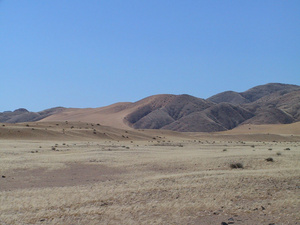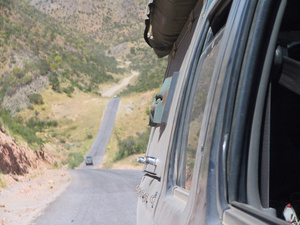Henk Dop: Namibia Trip Report 2005
Purros, Opuwo, Giribesvlakte, Sesfontein, Joubert Mountains, Ovahimba
Thursday 5 May: Purros - Opuwo, 273 km
We get up right early as today's driving may lead us anywhere, the Guineafowls' morning concert accompanies the breaking up of camp, and head out at 0700. We take the Northern exit from the Camp, bypassing Purros and joining the D3707 to the North of the Hoarusib. The road isn't bad - it's awful, it's worse than that. The corrugation is almost 10 cm deep, inescapable at any speed below the ludicrously dangerous, and the detours aren't any better. A steady, vicious pounding is all I get on the few km's that we try. That settles it - we're turning back.
Following the D3707 back to Purros, we must cross the Hoarusib and enter into a maze of tracks through different arms that all look equally sandy. A group of young men are filling in a really bad section with rocks, and confidently expect the V6 to be able to pass over their rough initial works. The Nissan doesn't let them down, and we proceed through the wide main arm up into Purros. Purros turns out to be another place that might well have been called 'Wereldsend'. A few dozen shacks and huts, many of them proclaiming to be able to fix tyres, that's about all.
The road back through the Gomatum valley is much easier in the more moderate light and temperature of the early morning, and actually now a fun drive. As we enter the Giribesvlakte we find it full of wildlife: a couple of Rüppels Korhaan with two chicks, a well-fed Jackal nearby, and in the centre of the plain an enormous group of Springbok right on the road and Oryx in the distance. Though more pleasant, it's still slow going and we don't get to Sesfontein until 1200, turning left on the C43 towards Opuwo at 1230. The views to the rear of us are stunning as we slowly ascend up into the central plateau again, with the Joubert Mountains in front of us. The vegetation becomes more lush, dominated by Mopane woodland. Groups of Springbok alternate with the brown cattle of the Ovahimba, the famed branch of the Ovaherero people living in the Kaokoveld, still largely clinging to their traditional lifestyle and characteristic dress.
Coming into the Joubert Mountains, the road narrows, winding down through a riverbed, and suddenly, there's a mountain in front of us, with a tarmac track leading seemingly straight up. We laugh, it's a sight to behold, and the track does indeed go straight up, there's nothing seemingly about it. In fact, the V6 refuses to go up in first gear, so I put her into low gear and we gently get to the top of Joubert Pass. Stopping for a photo, the view to the rear is every bit as much straight down. Before the tarmac, this must really have been a fun pass - perhaps even a rival to the incredible Spreetshoogte pass which we did from the 'wrong' direction in 2001. More and more small Ovahimba settlements now start to appear. A group of young girls along the side of the road typify what many visitors seem to want first and foremost from their visit to the Kaokoveld. In their leather aprons, leather, skin and hair smeared with the typical Ovahimba mixture of butter and ochre, they swing their naked breasts at us, inviting us to take photographs - for a small fee, no doubt. More blessings of tourism!
Coming closer to Opuwo, we enter a delightful valley where the monotonous Mopane woodland is suddenly interspersed with Baobab, which then inexplicably disappear again. We stop briefly to check the fridge: it seems to be working again, much to our cautious delight. At the junction with the road to Kaoko Otavi, a couple of young man jump up from out of the shade, shouting at us. We conclude that they had indeed shouted 'Water!', and turn back. There's a 'Baie, baie dankie, meneer!' as Maarten hands them a bottle of the precious liquid, and much waving as continue on our way.
Opuwo is now quite close, and we once again note that the vehicles of visitors seem to outnumber local vehicles by at least three to one. Though this impact may have some undesirable side-effects as we've already noticed, it's clear that the local economy depends on these strangers in a quite considerable manner. It's also one of the causes why Opuwo, which we enter at 1500, is clearly a boomtown. There's construction going on just about everywhere, and the mixture of modern Western dress and flapping ochre breasts is quite a sight.
We stop at the Super Save supermarket in downtown Opuwo, and despite Opuwo's rush into modernity this is clearly not a shop very much frequented by visitors, so we're now refreshingly on display ourselves. The BP station even has unleaded fuel, ending any need for careful considerations of our mileage and fuel consumption. While the car is being filled up, Marike is besieged by sellers of Ovahimba curio's, she buys some, which also results in ochre smears on her hands and arms.
Again based on Thomas Richter's site, we head for the Ovahimba Traditional Campsite, just a few km out of town. It turns out to be a pleasant, clean and spacious site, the 'traditional' being formed by the lay-out of the stones around each site, following the symbolism of Ovahimba architecture and the position of each house towards the sacred fire that is the centre of each Ovahimba homestead. We're also offered to go and visit a 'traditional village' in the morning, which we politely decline. The birdlife is prolific, Rüppels Parrots are all around.
Maarten makes a spectacular fire, and we produce another fine potjiekos. Too much of it, in fact, but the site's watchmen need only seconds to help us solve that problem. A couple of Germans arrive well after dark, and install themselves at the site next to us. When we have a chat, they turn out to be wholly ignorant of the dangers of driving in the dark. 'We haven't seen any Kudu'. The answer to that is simple: by the time you do, it's usually too late. Just a week after the end of our trip, a crossing Kudu appeared to have been the cause of Namibia's most horrific road carnage ever, resulting in a truck laden with 40 tons of copper ore ploughing straight through a passenger bus and leaving 27 people dead.


